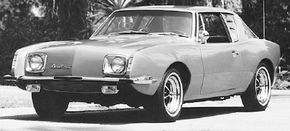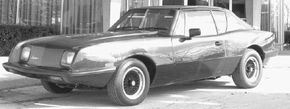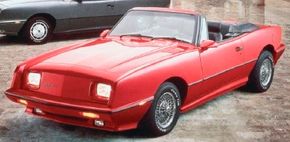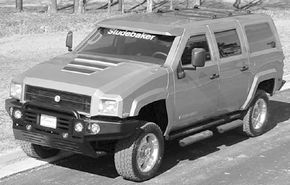Studebaker fled to Canada in late 1963 and left the auto business three years later. By that time, Leo Newman and Nathan Altman had resurrected the Avanti, Studebaker's most interesting car of the '60s.
Designed by a team under Raymond Loewy, the Avanti had failed Studebaker in the marketplace but succeeded greatly with enthusiasts -- the only Studebaker in two generations to inspire such interest. Before its phaseout upon Studebaker's departure from South Bend, the Avanti had broken virtually every major U.S. Auto Club speed record.
Advertisement
Newman and Altman were partners in a South Bend Studebaker dealership, one of the oldest. Knowing the Avanti was too good to lose, they bought the name, production rights, tooling, and a portion of the century-old South Bend plant where the Avanti had been built. In 1965, they began turning out a revised version called Avanti II. They hoped to make 300 a year, which they'd never manage, but output was adequate and consistent.
Unlike the original, Avanti II was a commercial success. Its fiberglass body meant no expensive sheetmetal dies to maintain. And because Newman and Altman had conceived their Avanti as more exclusive than Studebaker's, they could build it carefully and largely by hand on a small assembly line. That meant they could tailor each car to the customer's wishes.
Well-heeled buyers could push the $6550 base price beyond $10,000. Options included Hurst four-speed manual transmission, power steering, air conditioning, electric window lifts, tinted glass, AM/FM radio, Eppe fog or driving lights, limited-slip differential, Magnum 500 chrome wheels, and Firestone bias-ply or Michelin radial tires.
Early Avanti IIs had vinyl interiors, but textured "Raphael vinyl" could be ordered for $200. Genuine leather seat and door trim added $300, full leather $500. Paint colors were anything a buyer wanted, as were interior trims in later years. Though this led to some bizarre cars, it was part of the "custom-built" aura and it helped sales.
Early IIs retained the original Avanti's modified Lark convertible frame, but Studebaker V-8s were gone by the time Newman and Altman started, so they followed Studebaker's own lead by adopting the same 327-cubic-inch Chevrolet small-block in 300-horsepower Corvette tune.
Chevy then introduced a 350-cid enlargement, and Avantis got it in 1969, though rated power was unchanged. Transmissions were either a fully synchronized Borg-Warner four-speed manual or a "Power-Shift" automatic that permitted manual hold of first and second gears.
These new mechanicals resided in a body almost identical to the original Avanti's. The main visual differences were a more level stance (Altman's customers disliked the Studebaker's marked front-end rake), Avanti logos with suffix Roman-numeral IIs, and reduced-radius wheel openings.
Corvette power made for fine performance in the sleek four-place Avanti. The typical automatic car could run 0-60 mph in under nine seconds and hit 125 mph with a 3.54:1 rear axle. Better still, the Chevy engines were lighter than the old Studebaker V-8, so front/rear weight balance improved from 59/41 percent to 57/43. Power front-disc/rear-drum brakes resisted fade admirably, while providing quick deceleration of nearly 1g in 80-mph panic stops. Obviously, Newman and Altman cared about safety as much as straight-line performance.
Being custom-built, the Avanti II necessarily cost more than Studebaker's version, competing in Cadillac Eldorado territory instead of Chrysler country like the $4,445 original. Realizing this meant a change in market orientation, Newman and Altman pitched the II more on "personal-luxury" than performance.
And indeed, the car was in its element on the open road. Magazine testers gave it points for safety, quietness, structural rigidity, and a firm but comfortable ride. "In this day of great concern over automotive safety," wrote John R. Bond in 1966, "the Avanti II should make new friends, for obviously there was more thought given to safety in its conception than in most American cars ... It's a better car than it was three years ago."
For more on defunct American cars, see:
- AMC
- Duesenberg
- Oldsmobile
- Plymouth
- Studebaker
- Tucker
Advertisement




